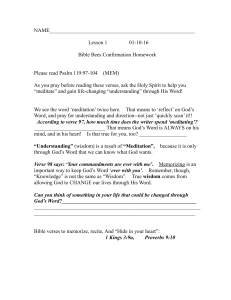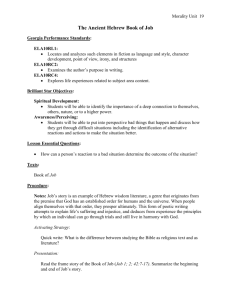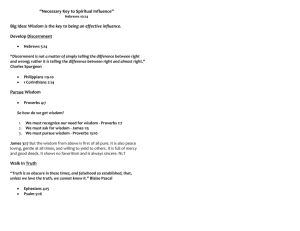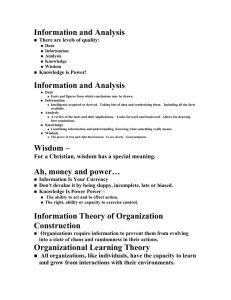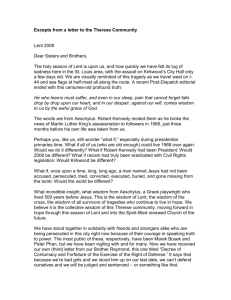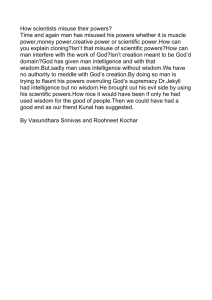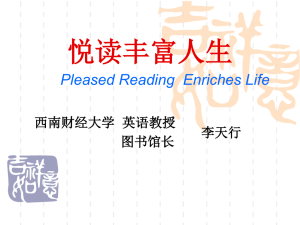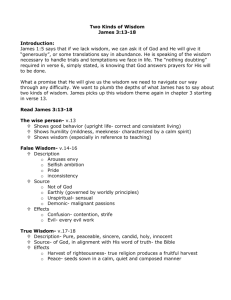An Introduction to Buddhist Wisdom Teachings
advertisement
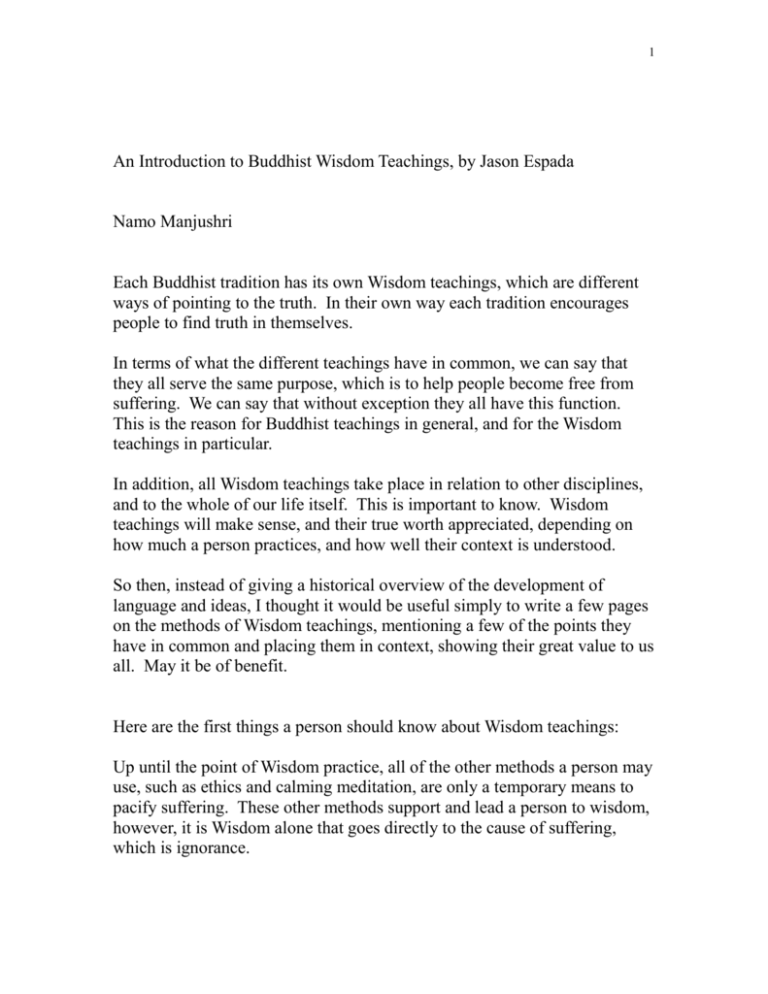
1 An Introduction to Buddhist Wisdom Teachings, by Jason Espada Namo Manjushri Each Buddhist tradition has its own Wisdom teachings, which are different ways of pointing to the truth. In their own way each tradition encourages people to find truth in themselves. In terms of what the different teachings have in common, we can say that they all serve the same purpose, which is to help people become free from suffering. We can say that without exception they all have this function. This is the reason for Buddhist teachings in general, and for the Wisdom teachings in particular. In addition, all Wisdom teachings take place in relation to other disciplines, and to the whole of our life itself. This is important to know. Wisdom teachings will make sense, and their true worth appreciated, depending on how much a person practices, and how well their context is understood. So then, instead of giving a historical overview of the development of language and ideas, I thought it would be useful simply to write a few pages on the methods of Wisdom teachings, mentioning a few of the points they have in common and placing them in context, showing their great value to us all. May it be of benefit. Here are the first things a person should know about Wisdom teachings: Up until the point of Wisdom practice, all of the other methods a person may use, such as ethics and calming meditation, are only a temporary means to pacify suffering. These other methods support and lead a person to wisdom, however, it is Wisdom alone that goes directly to the cause of suffering, which is ignorance. 2 For a person practicing as taught, the method of Wisdom is able to end the struggle and conflict of dealing with suffering just on a superficial, emotional level. This can be exhausting, and what's more it's not enough. Wisdom also removes the fear that is a part of only having provisional methods to use. While these are necessary supports, somewhere we know that more is needed. Even early on in learning we can sense that the method of Wisdom is sufficient. Because it deals with the cause and not just with the result of suffering, we can sense that Wisdom can put a complete stop to the cycle of repeated dissatisfaction that is samsara. This the best possible news. It is Wisdom that gives 'the gift of fearlessness'. This is a gift we can give ourselves. As long as a person continues to cultivate, they can reasonably expect a lessening of wrong view and afflictive emotion. As the Buddha taught, Wisdom is the actual means by which we can purify ourselves. Just knowing this brings another type of calm; it brings faith, and more energy to study and to practice until the result is achieved. Wisdom begins with awareness. Then we can notice that when we practice mindfulness it can be something more than just the mere registering of phenomena. There can also be more knowing. Mindfulness can be of the nature of discernment, or clear comprehension, and it is this type of awakened intelligence that we should use, both in our daily activities, and in any practice we may do. This discernment we develop is helpful to us not only in maintaining good ethics and in meditation, it is also the most useful quality in cultivating Wisdom. The reason is that the very essence of Wisdom is discriminationtelling what is what, or telling the true from the false, cutting through illusions. It's for this reason that it's taught that in meditation we should try to 'further and sharpen this bright awareness'. This means no spacing out, or trance-like quality. In fact, we go in the other direction: be awake ; be alert; be present; develop discriminating mind. 3 In a clear, bright mind of discriminating awareness, no delusion or cause of suffering can grow. This is our protection. This mind is without projections, or imaginings, and it breaks down the remainder of past thought on deeper and deeper levels of mind. We become freer as a result. More specifically then, what is Wisdom as expressed in Buddhist teaching, and how are we to develop that in ourselves? Wisdom, as the Perfection of Wisdom, is both relative, seeing what will benefit in a particular situation, and also being established in the truth state, in this moment being clear, without the least trace of wrong view. The Wisdom taught by the Buddha is the realization of ego-lessness, and non-duality. Having this liberating insight is also sometimes called the experience of 'emptiness'. You might ask, 'Empty of what?'. The answer is empty of ego, or of an 'I'. As one teacher put it though, ego-lessness shouldn't be taken to mean that the ego exists and then we get rid of it; instead it means that we see the ego never did exist in the way we once believed. When we search into our own body and mind for what we call 'I', or for what we are called by name, we find that what we usually hold to be an 'I', or a 'me' is a fiction, a concept. We have mistaken the ego to be what we, ourselves, actually are, and what other people actually are. There are many levels to this. The 'I'-grasping ignorance manifests especially strongly when experiencing either anger or attachment. However, that person you conceive of when you think of an ordinary, limited, permanent person- that person doesn't exist. That is a mistaken consciousness, and it is precisely this imaginary egograsping that is the root of all problems. As Dudjum Rinpoche said, that which has kept us in samsara (the cycle of repeated dissatisfaction) is the grasping and the grasped. This is the cause of the emotional afflictions. Such ego-grasping is also called 'self-grasping ignorance', or 'dual-grasping ignorance'. Ultimately, this has no basis. 4 As an experiment, right now, tell me, what you imagine- is it real or not real? Of course you can say that it is real in a sense because it produces effects, (like when a person mistakes a rope for a snake), but ultimately we know that it is not real. This is what is meant by there being different modes of existence, or different levels of mind or of truth. There is a way the ego does exist, but it is different from what we have in our mind. We have thought up a mundane, permanent, independent 'self', and taken hold of it as real. This is wrong view. Any time we fixate on things, ourselves or others, as existing in a particular way, we are hallucinating. (This is sometimes called 'reification'.) Actually, as we can find out for ourselves, anywhere there is life there is an unfathomable depth of being. If we are attentive though, sometimes we can notice how we project our imaginings instead onto what is here, and mistakenly believe them to be true. This tendency, and the remainder of having done this in the past influence our perception more than we may know. And it is this mistaken understanding and the effects of taking what is made up by our own mind as being ultimately true, that is changed on every level by Wisdom practice. With introspection and study we find that the way we experience is very much related to language, to our naming of things, or to what is called 'labeling'. The Indian sage Dharmakirti is quoted therefore as saying: 'By means of understanding the conventional level of truth, and ascertaining the manner in which mental labels and conceptualization affect the perceptual process, one perceives the final mode of the actual presence of phenomena. As it is the gateway to the deeper meaning of things, the wise practice in this manner.' 5 With careful attention reaching insight, we can see that what was taken hold of is not, and never has been true. At the same time, and this is an important point, we can see something else- we can see what is real, stable and lastingthat which is our own true nature, just as it is. It's taught that our discriminating wisdom completely and absolutely destroys the ignorance of ego-grasping, the cause of suffering. We bring the light of illumination, and with greater strength of comprehension, we cut through the seemingly concrete sense of 'self'-existence. One of the meanings of the images of destruction in mythology and iconography in fact, is just this total destruction of the ignorance of egograsping. They refer to that transformation of experience. How are we to approach having this experience for ourselves? What are the methods? Upon investigation we find that, along with unawareness, one of the things that perpetuates self-grasping is self-cherishing, or the attachment to 'one's' own pleasure. So we can see why the practices of morality and compassion are recommended from the beginning, to first pacify the gross manifestations of ego. Then we can go further through meditation. There are different ways of approaching the cultivation of wisdom. One is through analysis, as mentioned above. We look carefully for what we are called by name, for what we specifically conceive of as 'I' throughout our body, sensations, mental formations (also called 'tendencies), and consciousness. To uproot the ego-clinging delusion, the cause of samsara, it's been said that it won't do to have only some sort of vague idea of the 'I' that we take hold of as being who we are. Instead it's essential that, moment by moment, we have as clear a perception as possible of the image or feeling of the 'I', or of who we consider ourselves to be. Then we can benefit from sharp analytical investigation. (Keep your mind clear. Keep your knowing sharp.) 6 When we grasp a 'self', the idea that we have is of a fixed, permanent identity. When we think about this though, right away we can tell it's not accurate. In this way we find that the recognition of impermanence can help with the realization of emptiness. Definitely this is a clue. Bhikku Khantipalo wrote, 'Intensively examine every dharma, (form, sensations, perceptions, mental formations, consciousness), every momentary experience as it arises and passes away for any sign of (what we conceive of) as 'self'.' After investigation, and seeing that there's nothing to find, no such 'I' at all there in the five aggregates, then don't look any further- you've already found what's to be found, just rest your mind with that, familiarize yourself with that recognition. Beginning with ourselves in this way, what we find also holds true for others- we can recognize that they too are not merely what we conceive. When we see that the image we hold (in ourselves, or that we project) is without a factual basis, then it has to disappear, or at least the misidentification will lessen, gradually fade, and eventually vanish altogether, taking with it the accompanying emotional afflictions. The subject and objects of attachment are actually non-existent; Seeing this purifies attachment. And the subject and our objects of anger are essentially non-existent; (imaginary)- seeing this fully purifies anger. Just so, the three poisons of attachment, anger and ignorance are cut at their very root by this one practice of Wisdom. When we see illusions as illusions they lose their power over us. This is the essential point of practice. Bokar Rinpoche compares this function of insight as being like seeing a stuffed tiger for what it is, and completely losing any fear we might have had. The way to make the above method effective is to practice alternating samatha and vipassana (calm and insight) meditation, reviewing the points of analysis, and then to combine the two. 7 There is a line in 'Heartwood of the Bodhi Tree', by Buddhahasa Bhikku, that 'Nothing whatsoever should be grasped as 'I' or 'mine'. We can also say, 'Don't grasp anything created by the mind as being real.' And, not even the 'emptiness' of the 'I' should be grasped. These are good to remember and meditate on. Here's a verse: Meditate one-pointedly on the absence of constructs as your own true nature Right meditation on emptiness destroys mistaken thought forms, swiftly and easily, like taking a hatchet to balsa wood (or, as one teacher said, 'like a snowflake in a furnace') As mentioned earlier, the method of negation, of saying 'not this, not this' does lead also to something affirmative, in the words of the Diamond Sutra, something 'ungraspable and non-deceptive'. After analysis we can familiarize ourselves with that state (of bliss, and freedom). Swami Sivananda said, 'After destroying all false imaginings become That which remains.' (without grasping, and without concepts). In addition to the method of analysis and familiarizing ourselves with what is found after analysis, there is another way to the realization of our nature, and it is through a more intuitive approach. There are times in practicing meditation when mindfulness, as stability and clear comprehension, opens up and becomes Awareness, or Wisdom, a self-knowing state. All paths and practices are contained in this state. One instruction by Tilopa says, 'Don't think about the past, Don't imagine anything about the future, Don’t analyze anything in the present, Don't contemplate, 8 Don't concentrate, Don't meditate. Leave your mind in its natural state.' Let go of the past. Let go of the future. Let go of the present. What's left? Rest your mind in a state of natural ease, without grasping or holding anything, and with your mind very clear and aware, very sharp and precise. Familiarize yourself with that. Knowing emptiness in this way is also called 'knowing the true nature of mind'. This experience is also called 'the view'. Sometimes we hear, 'Dissolve your concepts completely', or 'Allow your concepts to dissolve'. It's taught that, 'The view is there upon the dissolution of the conceptual mind'. As far as the method of meditation here, Tulku Urgyen Rinpoche describes it like this: 'Try now in your meditation practice not to maintain anything whatsoever. We should be free not only from the surface and underlying thoughts, but also from the deep seated thought constructs as well, which are what conceptualize the meditation state. 'We need to become used to the natural dissolving of thought through training. By allowing the expression of thought activity to naturally subside, again and again, the moments of genuine rigpa (non-dual awareness, selfexisting wakefulness) automatically and naturally begin to last longer. 'Do not create or construct anything whatsoever. Leave your present wakefulness, which is the buddha nature itself, totally unmodified. Do not try to correct or alter anything. Leave it free, as it naturally is. 'The first point, then, is deliberate mindfulness. The next moment is seeing your nature. At that time you should allow for an ongoing state of naturalness. 9 'All the different speculations should be dropped completely. In the moment of seeing, allow for a continuity free from thought. Simply rest freely in that. 'Realizing the view, authentically and totally, melts away the obscurations of karma and disturbing emotions, and this allows the qualities of original wakefulness to unfold.' (These lines are selected from the book 'Rainbow Painting'.) As we can see, the meditation on emptiness either explicitly or implicitly negates limited concepts of 'self', 'other', and the world. We can take up whichever method for cultivating insight we prefer, whatever works for us. Whatever our approach, however, we will need both of these elements- of stability, or continuity, and discriminating awareness. In this process that we are engaged in, of cultivating Wisdom, it's also traditionally been taught that it helps us a lot to be in the presence of those who have awakened a deep realization. As there are layers of mind, there is much depth and subtlety that can be known sympathetically. It helps us to hear their voices, to see their pictures, to hear their words, or to think of them. (I think of Nisargadatta Maharaj, Ramana Maharshi, Swami Sivananda, Bokar Rinpoche, Lama Yeshe, the Dalai Lama, the Karmapa, Thich Nhat Hanh, Hazarat Inayat Kahn, Kenpo Palden Sherab Rinpoche, Tulku Urgyen Rinpoche... These are illumined beings.) You can think of the excellent qualities of any teacher with whom you have an affinity. To be in their presence is referred to as 'satsang', or 'association with the wise'. Association with the wise is association with wisdom itself. We can benefit a lot from this. We should also clearly understand the need for our own continued application, and our own development toward deeper, more effective practice. 'Practicing correctly is your own responsibility.' Up until now we may have 'practiced' self-grasping, or 'I' grasping for a long time. We may have done it day and night, but this has all been delusion. 10 If all it took to be without wrong view was to have it explained once, then the practice would be very easy. But what happens is that thoughts that are the product of past thought and experience arise in us like a wave, and again there is wrong view, some negative experience or afflictive emotion. Even when these negative experiences are not that noticeable, the potential for them can still be there, waiting to be triggered. A discerning mind will see if it is so. For example, we can find within ourselves the subtle sense of 'attachment (or anger) without an object'. This is the awareness of a tendency. Wisdom practice progressively destroys wrong view and afflictive emotion, both in their manifest and latent forms. As it is taught in the Pali scriptures, we should practice to the point of 'forsaking the substratum of existence' of delusion. With stronger and more profound realization, and continued practice, we can reach the stage where realization is complete. Because of the fact that ego-grasping goes deep, we need to generate a mind that is able to counteract this ignorance on every level - otherwise we will have left the cause of suffering intact. The opposite of the most subtle mind that grasps the existence of ‘self’ is the most subtle mind that perceives the non-existence (or emptiness) of this. This is what we need to cultivate. There is no doubt that we need to cultivate subtlety and strength of realization. In addition, we need to engage with consistency in the practice, so that we don’t undo the good results we’ve achieved in the more formal sessions. Here, an ‘on and off’ practice won't do. It won't work. It's been said that delusions don't need our help- they happen automatically, but that freedom from wrong view and afflictive emotion needs our continued practice of mindfulness and discernment. It's important therefore that we try to cultivate discriminating wisdom both in meditation and in the course of our daily lives. When there is egograsping we should first be aware when this is happening. (We can think: 'Here is an illusion of 'self'') Then we should practice 'cutting through', or seeing through, and being without self-grasping. (Imaginings disappear. Don't traffic in fictions!) (Note: this may be easier to do with ego-grasping that is neutral in terms of its feeling quality- without the attendant emotional afflictions such as 11 attachment or anger. Then we can gradually build up our strength of mind.) Although selfishness and 'I' grasping ignorance are sometimes deeply ingrained tendencies, and although they may take quite a bit of application on our part to change, still this is something that is possible for us to accomplish. Through meditation we can resolve what Lama Thubten Yeshe called 'the organic problem of ego'. We should know this is possible, and that it is something most worthwhile- it is the way to our own liberation from suffering, and to our being able to help others. In 'Ceaseless Echoes Of The Great Silence', Palden Sherab Rinpoche says the following about the importance of continued right contemplation: 'We must deepen our understanding by contemplating thoroughly what we have read and heard. This stage of wisdom arrived at through contemplation is very clear and certain: it is called certainty wisdom. It is very important to reach the level of certainty wisdom in all the areas of our lives. Otherwise we will be allowing our minds to rest in states of subtle confusion, denying ourselves the success and fulfillment of lessons truly learned. 'When we contemplate successfully, we do not simply accept what has been taught. We use our intellect to analyze over and over again, until we feel certain that our projections, exaggerations, and fantasies have been eliminated. We are trying to discover exactly what is; to do this, we must constantly refer to what we have learned about the absolute nature, keeping our minds clear of the extremes of nihilism and externalism.' It's worth mentioning here a number of the factors that are necessary for the continued functioning of wisdom to be possible. We should each do our best to maintain these supports for having a correct insight practice. We are so much more than ego; not small, not separate, nothing mundane here. A person is something precious; inconceivable, 'ungraspable and nondeceptive'. To know this, however, and to meditate with this recognition, we need freshness of mind, and to have much good, appreciative, affectionate energy; we need to have cleared away a lot of the remainders of negative thought and feeling; and we need, to some extent, to have developed stability of mind, and sharp, clear awareness. This means accumulating merit, doing purification practice, and a lot of quiet meditation. 12 Then in all our studies we have to be careful to avoid either of the two extremes- on the one hand, that of taking the ego to be real, or on the other, that of denying what is here. If we deny what is here (because 'it's all empty') we would neglect karma, and if we assert too strongly what we perceive as being all there is, that is delusion, the root cause of suffering, and cyclic existence. The way to remedy both extremes is to have both a good heart and understanding. Mercy, or loving-kindness keeps our karma right, and understanding, or wisdom keeps us from grasping too absolutely at appearances. Our wisdom and compassion should always be together. For some people, the path of having love for all is itself a way to the intuition of Truth. Whatever method we choose though for the cultivation of wisdom, it is our having this quality, of loving kindness, that provides clarity, a sense of richness, and a ripening warmth in our lives. On any path of Wisdom, the development of love, then, is something necessary for each of us, for our full development. Love is there from the beginning, and it should develop as a matter of course. There are many levels to the cultivation of Prajna, or Wisdom, and all along the way the unfolding of our understanding naturally leads to having more kindness, compassion and generosity. It has to be this way because our nature is this, and because we can see more of the worth of living beings. We can also see the mistakes of mind that people make that lead to suffering, and how much of it is unnecessary. Out of our own freedom then we can have empathy, and this together with our own capacity to help brings a sense of responsibility towards other people. Since the way we share what we know is primarily through our own practice, we'll want to realize further and give of ourselves, in line with the wish, 'May all be free from suffering and the causes of suffering', ' May all be free from self-clinging.' The development of compassionate wisdom is, then, the main point of one's own study and practice. It is the basis for our service.
